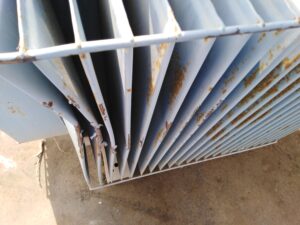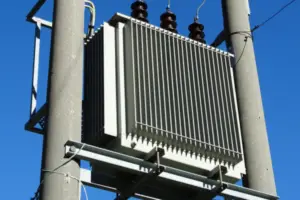Transformer oil leaks can have significant consequences on the performance, safety, and lifespan of transformers.
It is crucial to identify and address oil leaks promptly to prevent environmental damage, safety hazards, and costly equipment failures.
This article explores the signs of transformer oil leaks, their impact, and potential solutions for effective mitigation.
Table of Contents
Signs of Transformer Oil Leak
Visual Indications
One of the primary signs of a transformer oil leak is the presence of oil stains or puddles around the transformer.
These stains may be visible on the ground or on nearby surfaces. Additionally, the transformer components may exhibit discoloration or corrosion, indicating a possible oil leak.
Smell and Odor
Transformer oil has a distinct odor, and a strong, pungent smell in the surrounding area can be a sign of an oil leak.
If you notice an unusual or overpowering smell near a transformer, it is essential to investigate the source and address it promptly.
Electrical and Performance Issues
Transformer oil leaks can lead to decreased cooling efficiency, resulting in elevated temperatures and potential overheating.
This can cause insulation breakdown and arcing, leading to electrical failures or even fires. Monitoring systems can help detect abnormal temperature and pressure fluctuations, providing early warning signs of an oil leak.
Impact of Transformer Oil Leak
Environmental Consequences
Transformer oil leaks pose significant environmental risks. The oil can contaminate soil and water sources, potentially harming ecosystems and groundwater quality.
It is crucial to prevent oil leaks to safeguard the environment and protect flora and fauna.
Safety Risks
Oil leaks create safety hazards, especially in the vicinity of transformers. The leaked oil can become a fire hazard, especially if it comes into contact with an ignition source.
Moreover, individuals working near transformers may be exposed to electric shock and arc flash hazards due to compromised insulation caused by the oil leak.
Equipment Damage and Downtime
Transformer oil leaks can result in equipment damage and costly downtime. The leaked oil can corrode and oxidize transformer components, leading to the deterioration of insulation and other critical parts.
Ultimately, this can lead to transformer failure, requiring extensive repairs or even replacement.
Read also my comprehensive article: Unveiling the Hidden Dangers: Transformer Oil Loss Hazards.
Causes of Transformer Oil Leak

Several factors can contribute to transformer oil leaks. Aging and deterioration of the transformer over time can cause gaskets and seals to degrade, resulting in leaks.
Mechanical stress, including vibrations from nearby equipment or improper transportation, can also compromise the integrity of the transformer and lead to oil leaks.
Furthermore, manufacturing defects or faulty installation can be underlying causes of oil leaks.
Solutions for Transformer Oil Leak
Regular Inspections and Maintenance
Regular inspections are essential for detecting and preventing oil leaks. Visual inspections should be conducted to identify any visible signs of leaks, such as oil stains or discoloration.
Fluid analysis, including regular testing of the oil’s dielectric strength and chemical composition, can provide valuable insights into the transformer’s condition.
Repair and Replacement of Faulty Components
If a leak is detected, immediate repair or replacement of faulty components, such as gaskets and seals, is necessary.
Damaged insulation or cooling systems should also be repaired or replaced to prevent further leaks and ensure optimal transformer performance.
Upgrading to Hermetically Sealed Transformers
Hermetically sealed transformers offer improved protection against oil leaks.
These transformers have a sealed design that eliminates the need for gaskets and seals, reducing the risk of leaks and extending the transformer’s lifespan.
Consider upgrading to hermetically sealed transformers to minimize the chances of oil leaks.
Oil Containment and Spill Prevention Measures
Implementing effective oil containment and spill prevention measures is crucial to mitigate the impact of oil leaks.
Secondary containment systems, such as bund walls or basins, can help contain leaked oil, preventing it from reaching the environment.
Additionally, using oil absorbents and barriers can help quickly address and clean up any oil spills.
Conclusion
Transformer oil leaks can have severe consequences, including environmental damage, safety hazards, and equipment failures.
By being vigilant and promptly addressing signs of oil leaks, conducting regular inspections, and implementing appropriate solutions, the risks associated with transformer oil leaks can be minimized.
Prioritizing maintenance and implementing preventive measures will ensure the optimal performance and longevity of transformers while safeguarding the environment and promoting safety in the surrounding areas.
Don’t Leave Empty-Handed!
Install my Free Android App on Google Play:
Electrical Cables Most Common Tables “Cables Tables”
And, my Electrical Calculations App “Fast Electrical Calculator”
Discover more great content by subscribing to My channel
Looking to stay ahead of the game in the world of electrical engineering? Subscribe to my YouTube channel and gain access to exclusive content you won’t find anywhere else!
The staff I recommend
(Amazon Affiliate Links to products I believe are high quality):
- Economy 120 Volt/60Hz AC Power Source – Step-Down Voltage & Frequency Converters 1800W
- UNI-T Digital Multimeter Tester UT139C
- 50-Amp Extension Cord for RV “100ft”
- Voltage Stabilizer 110/220v
- Hair Dryer “best selling“
- TOSHIBA EM131A5C-BS Countertop Microwave Ovens
Disclaimer: This contains affiliate links to Amazon products. I may earn a commission for purchases made through these links.



